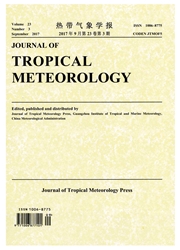

 中文摘要:
中文摘要:
A quantitative diagnosis is carried out for the upward branch of a local meridional circulation over southern China(SC) during the abnormal snowstorms with severe freezing rain from 10 January to 3 February 2008.The diagnostic study shows that the upward branch is mainly associated with the zonal advection of westerly momentum and meridional temperature advection instead of the latent heating(which is commonly the dominant factor in many other storm cases).The corresponding weather analyses indicate that(1) the zonal advection of westerly momentum represents the effect of the upper-level divergence on the anticyclone-shear side in the entrance of a 200 hPa westerly jet with a westward deviation from its climatological location over southwestern Japan;(2) the meridional temperature advection represents the interaction between the mid-lower layer(850 to 400 hPa) warm advection over SC(ahead of temperature and pressure troughs with the latter trough deeper than the former in the Bay of Bengal) and cold advection over north China(steered by an underlying flow at 500 hPa);(3) the relatively weak vapor transport(compared to that of spring,summer and autumn) from the Bay of Bengal and the South China Sea to SC and the existence of a temperature inversion layer in the lower troposphere over SC diminish the effect of latent heating.With the significant increase of vapor transport after 24 January,the role of latent heating is upgraded to become the third positive contributor to the upward branch over SC.
 英文摘要:
英文摘要:
A quantitative diagnosis is carried out for the upward branch of a local meridional circulation over southern China(SC) during the abnormal snowstorms with severe freezing rain from 10 January to 3 February 2008.The diagnostic study shows that the upward branch is mainly associated with the zonal advection of westerly momentum and meridional temperature advection instead of the latent heating(which is commonly the dominant factor in many other storm cases).The corresponding weather analyses indicate that(1) the zonal advection of westerly momentum represents the effect of the upper-level divergence on the anticyclone-shear side in the entrance of a 200 hPa westerly jet with a westward deviation from its climatological location over southwestern Japan;(2) the meridional temperature advection represents the interaction between the mid-lower layer(850 to 400 hPa) warm advection over SC(ahead of temperature and pressure troughs with the latter trough deeper than the former in the Bay of Bengal) and cold advection over north China(steered by an underlying flow at 500 hPa);(3) the relatively weak vapor transport(compared to that of spring,summer and autumn) from the Bay of Bengal and the South China Sea to SC and the existence of a temperature inversion layer in the lower troposphere over SC diminish the effect of latent heating.With the significant increase of vapor transport after 24 January,the role of latent heating is upgraded to become the third positive contributor to the upward branch over SC.
 同期刊论文项目
同期刊论文项目
 同项目期刊论文
同项目期刊论文
 期刊信息
期刊信息
